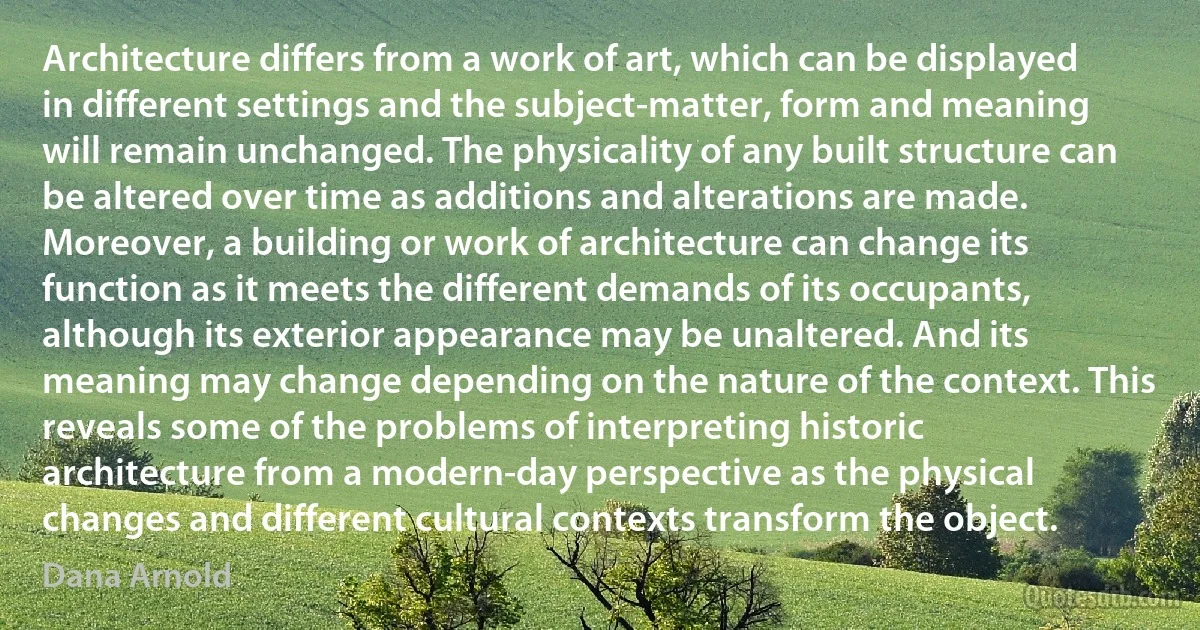Dana Arnold quotes
The invisibility of women in canonical histories might lead us to believe that women have no history. Surely then a female history is an essential tool in the emancipation of women? This is partly because if we have no history we are ‘trapped' in the present where oppressive social relations can continue unchallenged. Furthermore, history can be seen as evidence that things can and do change.

Dana Arnold
[A]rchitecture is more than a stage for the acting out of these performances. It offers a space for other social groups and kinds of social interactions. It is also important to remember that in examples such as the country house it was home to a large number of residents representing a variety of interests.

Dana Arnold
The purpose here is to demonstrate the diversity of classical formulae which appeared in architectural design, and if we look at classical architecture as a repertoire of forms rather than statements of specific design credos we can challenge teleological constructions of stylistic histories. The method of grouping the architecture from given periods of time under general stylistic labels has, without doubt, been the backbone of the discipline of architectural history. And when used skilfully and carefully it can provide useful punctuation marks in the lengthy and complex narrative that is the subject-matter of the history of western building. Yet it is only one of many tools with which to explore social and cultural contexts.

Dana Arnold
I am interested in how we interrogate architecture in terms of its social functions and meanings. Architectural historians writing on eighteenth and early nineteenth century Britain have tended to see social history as the answer to this question. But the social history of architecture or the histories of specific social groups which operated in and around the architecture or building(s), or indeed the spaces created by them or for them, provide only a backdrop or loose historical context.

Dana Arnold
Style remains a principal concern of the histories of British architecture from the sixteenth century to the early nineteenth century, if not up to the present day. Architecture and style are interlinked to the point that style can almost be believed to contain the essence of architecture, but if this were the case then style would constitute the subject of architectural history. Quite clearly it does not.

Dana Arnold
Histories based on biographies can present a one-dimensional image of the architects involved, often inflating what was a portion of their existence, interests or social and cultural significance, making architecture appear to be their driving force when in reality it may have been merely one of several interests.

Dana Arnold
[B]iography is an essential part of human memory. We think about ourselves in terms of what we have done – our identity is constructed around our past. Are history and biography linked or just two parallel strands? Biographers and historians make choices about how to frame their subject, they draw together fragments to present a possible glimpse of the unattainable whole. An historian might have a thesis or method which drives his/her enquiry whereas a biographer has, perhaps, a particular view of an individual they wish to present. Neither presents the truth, only an interpretation.

Dana Arnold
The influence of literary theory on its related disciplines has prompted much debate about the notion of ‘authorship'. Yet the attraction of exploring architecture, or more specifically a building, through the life of its architect (author) remains a significant force in the construction of its histories. This is particularly the case when the architect has been identified as a major figure in the evolution of the architectural history. Conversely, buildings without architects are pushed to the sidelines of history.

Dana Arnold
‘Architecture' may at first appear to be a more fixed and finite term. It has a threedimensional, tangible, useable form. But questions remain about what can be considered architecture and what cannot, and by this I mean that we usually understand architecture to incorporate aesthetic as well as functional consideration into its structure. Anything that does not fall into this category can be described as ‘just a building'. This may seem too simple. Can architecture be determined solely by the use of refined architectural style – high or polite architecture instead of vernacular?

Dana Arnold


